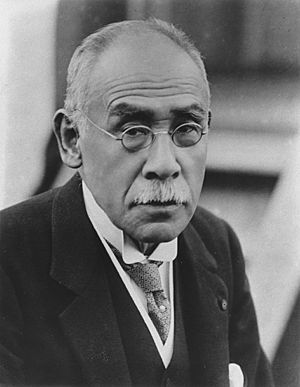Katō Takaaki facts for kids
Quick facts for kids
Count
Katō Takaaki
|
|
|---|---|
 |
|
| 14th Prime Minister of Japan | |
| In office 11 June 1924 – 28 January 1926 |
|
| Monarch | Taishō |
| Regent | Hirohito |
| Preceded by | Kiyoura Keigo |
| Succeeded by | Wakatsuki Reijirō |
| Personal details | |
| Born | 3 January 1860 Aisai, Aichi, Japan |
| Died | 28 January 1926 (aged 66) Tokyo, Japan |
| Cause of death | Pneumonia |
| Political party | Kenseikai |
| Spouse | Katō Haruji |
| Alma mater | Tokyo Imperial University |
| Signature |  |
Katō Takaaki (born January 1860 – died 28 January 1926) was an important Japanese politician and diplomat. He served as the 14th Prime Minister of Japan from June 11, 1924, until his death in January 1926. This time is often called "Taishō Democracy" by historians. He was also known as Katō Kōmei.
Contents
Early Life and Education
Katō Takaaki was born as Hattori Sokichi. He was the second son of a former samurai (a warrior class) from the Owari Tokugawa area in Nagoya. When he was 13, he was adopted by Katō Bunhei.
He went to Tokyo Imperial University. He studied law there, focusing on English common law. He graduated at the very top of his class.
After university, Katō worked for Mitsubishi, a large Japanese company group called a zaibatsu. He was sent to London for two years to work. When he came back to Japan in 1885, he became an assistant manager at Mitsubishi's main office in Tokyo. In 1886, he married Haruji, who was the oldest daughter of Iwasaki Yatarō, the head of Mitsubishi.
Becoming a Cabinet Minister
In 1887, Katō became the private secretary to Ōkuma Shigenobu. Ōkuma was the Foreign Minister at the time. Katō helped Ōkuma work on changing the "unequal treaties". These were old agreements that gave foreign countries special rights in Japan.
Later, Katō worked as the director of the Banking Bureau in the Finance Ministry. This role involved managing the country's money.
Diplomatic Roles and World War I
From 1894 to 1899, Katō served as Japan's representative to the United Kingdom. In 1900, he became the Foreign Minister. During his time in the UK and as Foreign Minister, he helped create the Anglo-Japanese Alliance. This was an important agreement between Japan and Britain, signed in 1902.
In 1902, he was elected to the House of Representatives in the Diet. The Diet is Japan's parliament.
In 1908, he became the ambassador in London again. He was given an honorary award, the GCMG. He became known as one of the strongest young leaders in Japan. He left his ambassador job in December 1912. After that, he served as Foreign Minister two more times.
Katō was the Foreign Minister when World War I began. He saw this as a chance to change Japan's relationship with China. He believed Japan should be a major world power, like the countries in Europe.
His decision for Japan to join World War I upset the genrō. These were older, powerful leaders who felt they should have been asked first. Also, in January 1915, Katō caused a big stir. He sent the Twenty-One Demands to China. This was a list of demands that caused a major international problem and a lot of disagreement within Japan.
Leading as Prime Minister
In 1915, Katō was chosen to be a member of the House of Peers. This was another part of Japan's parliament. The next year, he became the leader of the Kenseikai political party.
He strongly influenced the party's ideas. He was against the genrō and supported the constitution. He also believed that more people should have the right to vote.
Katō became the Prime Minister of Japan in 1924. He served until his death in early 1926. In 1925, he helped pass the General Election Law. This law allowed all male citizens over 25 to vote.
He also approved the Peace Preservation Law. This law aimed to stop leftist political groups. Katō also signed the Soviet–Japanese Basic Convention, an agreement with the Soviet Union. He also started a system of universal military service. Katō worked hard to lower government spending.
Katō Takaaki died while in office in 1926. He was 66 years old and passed away from pneumonia.
Honours and Awards
Katō Takaaki received many important awards and titles during his life and after his death:
- Grand Cordon of the Order of the Sacred Treasure (1902)
- Baron (1911)
- Viscount (1916)
- Grand Cordon of the Order of the Rising Sun with Paulownia Flowers (1916)
- Grand Cordon of the Order of the Chrysanthemum (1926; given after his death)
- Count (1926; given after his death)
Images for kids
See also
 In Spanish: Katō Takaaki para niños
In Spanish: Katō Takaaki para niños




